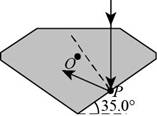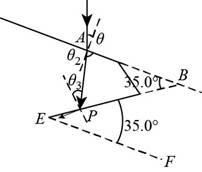
Concept explainers
(a)
The critical angle for total internal reflection for light in the diamond incident on the interface between the diamond and outside air.
(a)
Answer to Problem 28P
Explanation of Solution
Given info: The condition for light ray travelling between air and a diamond is shown below.

Figure (I)
From Snell’s law of refraction to air-diamond interface to find the critical angle is,
Here,
The value of
Substitute 1 for
Thus, the critical angle of refraction at air-diamond interface is
Conclusion:
Therefore, the critical angle of refraction at air-diamond interface is
(b)
To show: The light travelling towards point
(b)
Answer to Problem 28P
Explanation of Solution
Given info: The condition for light ray travelling between air and a diamond is shown in figure (I).
The critical angle for total internal reflection for light in the diamond incident on the interface between the diamond and outside air is
Conclusion:
Therefore, the angle of incidence is more than the critical angle all light is reflected from point P.
(c)
The critical angle for total internal reflection for light in the diamond when the diamond is immersed in the water.
(c)
Answer to Problem 28P
Explanation of Solution
Given info: The condition for light ray travelling between air and a diamond is shown in figure (I).
From Snell’s law of refraction to water-diamond interface to find the critical angle is,
Here,
The value of
Substitute 1 for
Thus, the critical angle of incidence at water-diamond interface is
Conclusion:
Therefore, the critical angle of incidence at water-diamond interface is
(d)
The ray incident at point P
(d)
Answer to Problem 28P
Explanation of Solution
Given info: The condition for light ray travelling between air and a diamond is shown in figure (I).
The critical angle for total internal reflection for light in the diamond incident on the interface between the diamond and water is
Thus, the light undergoes total internal reflection at
Conclusion:
Therefore, the light undergoes total internal reflection at
(e)
The direction in which the diamond is rotated such that the light at a point P
(e)
Answer to Problem 28P
Explanation of Solution
Given info: The condition for light ray travelling between air and a diamond is shown in figure (I).
The critical angle for total internal reflection for light in the diamond incident on the interface between the diamond and water is
The light will exit from the diamond only when the incident angle is less than the critical angle. So, to reduce the angle of incidence the diamond should be rotated in clockwise direction on the axis perpendicular to the plane of paper.
Thus, the light will exit at point
Conclusion:
Therefore, the light will exit at point
(f)
The angle of rotation at which the light first exit the diamond at point P
(f)
Answer to Problem 28P
Explanation of Solution
Given info: The condition for light ray travelling between air and a diamond is shown in figure (I).
Let the angle is rotated clockwise by
Apply Snell’s law at the water-diamond interface.
The condition of the situation is shown below.

Figure (II)
The angle at the vertex
The requirement is that the angle of incidence
Apply Snell’s law and find angle
Substitute
Thus, the diamond is rotated by
Conclusion:
Therefore, the diamond is rotated by
Want to see more full solutions like this?
Chapter 34 Solutions
PHYSICS:F/SCI.+ENGRS.,V.1
- Mick and Rick are twins born on Earth in the year 2175. Rick grows up to be an Earth-bound robotics technician while Mick becomes an intergalactic astronaut. Mick leaves the Earth on his first space mission in the year 2200 and travels, according to his clock, for 10 years at a speed of 0.75c. Unfortunately, at this point in his journey, the structure of his ship undergoes mechanical breakdown and the ship explodes. How old is Rick when his brother dies?arrow_forwardHi, I have canceled, why did you charge me again?arrow_forwardNo chatgpt pls will upvotearrow_forward
 Physics for Scientists and Engineers: Foundations...PhysicsISBN:9781133939146Author:Katz, Debora M.Publisher:Cengage Learning
Physics for Scientists and Engineers: Foundations...PhysicsISBN:9781133939146Author:Katz, Debora M.Publisher:Cengage Learning Physics for Scientists and EngineersPhysicsISBN:9781337553278Author:Raymond A. Serway, John W. JewettPublisher:Cengage Learning
Physics for Scientists and EngineersPhysicsISBN:9781337553278Author:Raymond A. Serway, John W. JewettPublisher:Cengage Learning Physics for Scientists and Engineers with Modern ...PhysicsISBN:9781337553292Author:Raymond A. Serway, John W. JewettPublisher:Cengage Learning
Physics for Scientists and Engineers with Modern ...PhysicsISBN:9781337553292Author:Raymond A. Serway, John W. JewettPublisher:Cengage Learning Principles of Physics: A Calculus-Based TextPhysicsISBN:9781133104261Author:Raymond A. Serway, John W. JewettPublisher:Cengage Learning
Principles of Physics: A Calculus-Based TextPhysicsISBN:9781133104261Author:Raymond A. Serway, John W. JewettPublisher:Cengage Learning College PhysicsPhysicsISBN:9781305952300Author:Raymond A. Serway, Chris VuillePublisher:Cengage Learning
College PhysicsPhysicsISBN:9781305952300Author:Raymond A. Serway, Chris VuillePublisher:Cengage Learning College PhysicsPhysicsISBN:9781285737027Author:Raymond A. Serway, Chris VuillePublisher:Cengage Learning
College PhysicsPhysicsISBN:9781285737027Author:Raymond A. Serway, Chris VuillePublisher:Cengage Learning





